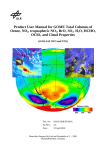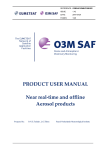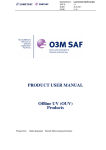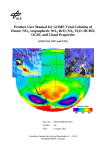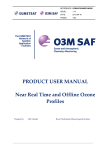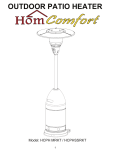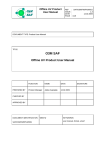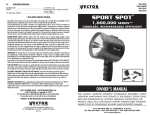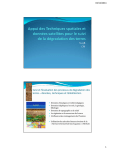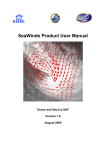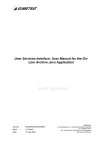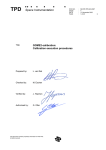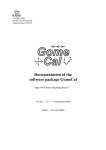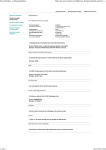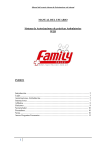Download DLR GOME Product User Manual
Transcript
Product User Manual for GOME Total Columnsof Ozone, NO2, SO2, BrO, H 2O, HCHO, OClO, tropospheric NO2, and Cloud Properties (O3M-SAF OTO and NTO) Dobson Units 200 Doc. No: DLR/GOME/PUM/01 Iss./Rev.: 2/C Date: 19 February 2010 DeutschesZentrum für Luft und Raumfahrt e.V. – DLR Oberpfaffenhofen, Germany 300 400 DLR/GOME/PUM/01 Iss./Rev. 2/C 19 February 2010 Product User Manual for GOME Total Columns of Ozone, NO2, SO2, BrO, H2O, HCHO, OClO, tropospheric NO2, and Cloud Properties Page 2 of 47 Signatures Action: Name Affiliation Function Date prepared by: D. Loyola R. W. Zimmer S. Kiemle P. Valks S. Emmadi DLR-MF DLR-MF DLR-DFD DLR-MF DLR-DFD GOME Project Manager GOME Project Engineer DIMS Project Manager GOME Project Scientist GOME Project Engineer BUFR v3 by: L. Butenko former DLR-MF GOME Project Engineer HDF5 by: Y. Livschitz former DLR-MF GOME Project Engineer 1 November 2004 released by: D. Loyola R. DLR-MF GOME Project Manager 19 February 2010 Signature 19 February 2010 14 June 2006 Distribution List Function Organization UPAS Team DLR-MF, DLR-DFD GOME/ERS-2 Team ESA, BIRA, RTS, AUTH, various O3M-SAF Team EUMETSAT, FMI, AUTH, BIRA, KNMI, various - 2- Product User Manual for GOME Total Columns of Ozone, NO2, SO2, BrO, H2O, HCHO, OClO, tropospheric NO2, and Cloud Properties Page 3 of 47 DLR/GOME/PUM/01 Iss./Rev. 2/C 19 February 2010 Document Change Log Issue Rev 1 A 1 Section Description of Change 31 July 2004 to 20 July 2006 all HDF5 and BUFR output product format documents merged in this product user manual B 5 October 2006 4, 5 Content of chapters added 1 C 10 November 2006 all First official version of this document 1 D 6 March 2007 5.7 6.2, 6.5 Fix file name convention Added VCDQualityIndicator, QualityFlags, CloudMode, CloudType, AMFTotal, AMFTotal_Error, OrbitActualDuration, new receiving stations 1 E 30 April 2008 all 6 7 Revised following ORR-A Added in HDF5 section: – IterativeVCDNumberOfIterations – a-priori O3_Profile – T_Profile BUFR product update to BUFR version 4 9 December 2008 28 January 2009 all Revised following ORR-B 6 Finalized HDF5 product format: – Moved trace gas specific datasets into own groups inside DETAILED_RESULTS – Moved cloud properties into own group 16 November 2009 6 Update H2O and HCHO format, new sections 6.6.4, 6.6.5, 6.7.4, 6.7.5 Minor corrections: – SurfaceAlbedoRW → SurfaceAlbedo – Total Columns and BrO cleanup 18 December 2009 6 PixelFlag under Geolocation section is renamed to SurfaceConditionFlag. SurfaceConditionFlag definition added. H2OFlag definition changed. 2 2 A B Date - 3- DLR/GOME/PUM/01 Iss./Rev. 2/C 19 February 2010 2 C Product User Manual for GOME Total Columns of Ozone, NO2, SO2, BrO, H2O, HCHO, OClO, tropospheric NO2, and Cloud Properties Page 4 of 47 19 February 2010 1.1 5.9.2 7.2 8 Add reference to reprocessed GOME-2 Add new O3M-SAF logo and web page Add WMO/GTS bulletin identifier New section - 4- Product User Manual for GOME Total Columns of Ozone, NO2, SO2, BrO, H2O, HCHO, OClO, tropospheric NO2, and Cloud Properties Page 5 of 47 DLR/GOME/PUM/01 Iss./Rev. 2/C 19 February 2010 Table of Contents 1 Introduction..........................................................................................................7 1.1 Purpose and Scope...........................................................................................7 1.2 References.......................................................................................................9 1.2.1 Applicable Documents...............................................................................9 1.2.2 Reference Documents................................................................................9 1.3 Abbreviations and Acronyms...........................................................................10 2 GOME Instruments............................................................................................11 2.1 Introduction...................................................................................................11 2.2 GOME/ERS-2...............................................................................................12 2.3 GOME-2/MetOp............................................................................................12 2.4 Measurement Scenarios, Timelines and Instrument Modes.................................13 3 Algorithm Description.........................................................................................14 3.1 Summary.......................................................................................................14 3.2 Trace Gas and Cloud Products........................................................................14 4 Processing...........................................................................................................15 4.1 GOME/ERS-2...............................................................................................15 4.2 GOME-2/MetOp............................................................................................15 4.3 Data Management..........................................................................................16 4.4 Quality Control and Monitoring.......................................................................16 4.5 Geophysical Validation...................................................................................17 4.6 User Services.................................................................................................17 5 Total Column Trace Gasesand Cloud Products..................................................18 5.1 Units.............................................................................................................18 5.2 Geographical Coverage and Granularity...........................................................18 5.3 Spatial Resolution..........................................................................................18 5.4 Delivery Time................................................................................................18 5.5 Expected Accuracy........................................................................................19 5.6 Product Formats............................................................................................19 5.7 File Name......................................................................................................20 5.8 Product Dissemination....................................................................................21 5.8.1 GOME/ERS-2........................................................................................21 5.8.2 GOME-2/MetOp....................................................................................21 5.9 Product Ordering...........................................................................................22 5.9.1 GOME/ERS-2........................................................................................22 5.9.2 GOME-2/MetOp....................................................................................22 6 HDF5 Product Format Description.....................................................................23 6.1 Structure.......................................................................................................24 6.1.1 Description of Common Items..................................................................25 6.2 META_DATA Group....................................................................................26 - 5- DLR/GOME/PUM/01 Iss./Rev. 2/C 19 February 2010 Product User Manual for GOME Total Columns of Ozone, NO2, SO2, BrO, H2O, HCHO, OClO, tropospheric NO2, and Cloud Properties Page 6 of 47 6.3 GEOLOCATION Group................................................................................29 6.4 TOTAL_COLUMNS Group...........................................................................31 6.5 CLOUD_PROPERTIES Group......................................................................32 6.6 DETAILED_RESULTS Group.......................................................................33 6.6.1 DETAILED_RESULTS/O3 Subgroup.....................................................34 6.6.2 DETAILED_RESULTS/NO2 Subgroup...................................................34 6.6.3 DETAILED_RESULTS/SO2 Subgroup...................................................35 6.6.4 DETAILED_RESULTS/H2O Subgroup...................................................35 6.6.5 DETAILED_RESULTS/HCHO Subgroup................................................35 6.7 Detailed Flag Description................................................................................36 6.7.1 SurfaceConditionFlag..............................................................................36 6.7.2 Quality_Flags..........................................................................................36 6.7.3 NO2Tropo_Flag.....................................................................................37 6.7.4 SO2_Flag...............................................................................................37 6.7.5 H2O_Flag..............................................................................................37 6.7.6 HCHO_Flag...........................................................................................37 7 BUFR Product Format Description.....................................................................39 7.1 Structure.......................................................................................................39 7.2 WMO/GTS Bulletin Identifier.........................................................................39 7.3 Section 0 - Indicator Section...........................................................................40 7.4 Section 1 - Identification Section.....................................................................40 7.5 Section 3 - Indicator Section...........................................................................40 7.6 Section 3 - UPAS Level-2 Specific List of Descriptors......................................41 7.7 Section 4 - Indicator section............................................................................42 7.8 Section 5 - End Section..................................................................................42 7.9 Trace Gas Table.............................................................................................42 8 Using the Products..............................................................................................43 8.1 Confidence Flags and Ancillary Fields..............................................................43 8.2 Software and Tools for reading the products....................................................43 A Appendixes.........................................................................................................44 A.1 HDF5 Data Types.........................................................................................44 A.2 Traceability Matrix of HDF5 Metadata to EECF Parameters.............................45 A.3 Traceability Matrix of HDF5 Metadata to UMARF Parameters.........................46 - 6- Product User Manual for GOME Total Columns of Ozone, NO2, SO2, BrO, H2O, HCHO, OClO, tropospheric NO2, and Cloud Properties Page 7 of 47 DLR/GOME/PUM/01 Iss./Rev. 2/C 19 February 2010 1 Introduction 1.1 Purposeand Scope DLR has been producing on an operational basis a range of total column trace gases and cloud products for GOME/ERS-2 in the framework of ESA’s D-PAF project. In the same way, DLR produces total column trace gases and cloud products for GOME-2/MetOp in the framework of EUMETSAT’s O3M-SAF. DLR has a long experience in operational processing of GOME data and has developed a generic software for this purpose: the Universal Processor for UV/VIS Atmospheric Spectrometers (UPAS) [A1] system. This document is the user manual for the GOME/ERS-2 and GOME-2/MetOp total column trace gases and cloud products available at DLR. In this document, the terms GOME/ERS-2 and GOME-2/MetOp are used to reference the specific instruments. The general term GOME applies to both sensors. The trace gasestotal column products are: ● Ozone (O3) total column ● Nitrogen dioxide (NO2) total column ● Sulphur dioxide (SO2) total column ● ● ● ● Bromide monoxide (BrO) total column Water vapour (H2O) total column Formaldehyde (HCHO) total column Chlorine dioxide (OClO) total column The trace gasestropospheric column products are: ● ● Nitrogen dioxide tropospheric column Ozone tropospheric column Additionally DLR provides the following cloud properties derived from GOME measurements: ● ● ● Cloud fraction (CF) Cloud-top albedo (CTA) and cloud optical thickness (COT) Cloud-top height (CTH) and cloud-top pressure (CTP) DLR provides near-real-time (NRT), off-line (OL), and reprocessed products. The NRT products have the same granularity as the input GOME data (i.e. downlink or PDU) and - 7- DLR/GOME/PUM/01 Iss./Rev. 2/C 19 February 2010 Product User Manual for GOME Total Columns of Ozone, NO2, SO2, BrO, H2O, HCHO, OClO, tropospheric NO2, and Cloud Properties Page 8 of 47 are made available and disseminated to the users within 2 hours 30 minutes of sensing. The OL products are consolidated orbits from ascending node crossing to ascending node crossing and are available and disseminated to the users two weeks (up to four weeks in case of GOME/ERS-2) after sensing. Additionally, DLR provides reprocessed products for climate applications. The complete GOME/ERS-2 data record starting in 1995 has been reprocessed and validated every two to three years using improved algorithms. In the same way, the complete GOME2/MetOp data record starting in 2007 was reprocessedand validated in 2010. GOME/ERS-2 and GOME-2/MetOp provide a unique data record of atmospheric measurements covering a time frame of around 25 years. DLR together with the partner organizations ESA and EUMETSAT will assure the continuity between GOME/ERS-2 and GOME-2/MetOp total column products. In this framework it is important to provide to the users a unified data format for accessing the GOME products. The “Hierarchical Data Format” (HDF) and the “Binary Universal Form for the Representation of meteorological data” (BUFR) have been selected for the GOME total column products. HDF and BUFR are self-describing, machine-independent file formats commonly used for storage and transfer of scientific and meteorological data. The present document is divided into the following sections: ● ● Overview of the GOME/ERS-2 and GOME-2/MetOp instruments including instrument modes Summary of the algorithms used for the retrieval of trace gasestotal columns and cloud properties ● Summary of the processing steps ● Product description including the used HDF5 and BUFR format ● Appendixes - 8- Product User Manual for GOME Total Columns of Ozone, NO2, SO2, BrO, H2O, HCHO, OClO, tropospheric NO2, and Cloud Properties Page 9 of 47 DLR/GOME/PUM/01 Iss./Rev. 2/C 19 February 2010 1.2 References 1.2.1 Applicable Documents [A1] Design Document for the GOME-2 Universal Processor for Atmospheric Spectrometers, SAF/O3M/DLR/DD/001, Issue 2.0, October 2003 [A2] EECF to PAF Interface Specifications, ER IS EPO GE 0102, Issue 3.0, January 1990 [A3] UMARF to SAFs Interface Control Document, EUM/UMA/ICD/004, Issue 3.12, April 2006 [A4] Product Requirements Document, SAF/O3M/FMI/RQ/PRD/001, Rev. 06, May 2008 1.2.2 ReferenceDocuments [R1] “Algorithm Theoretical Basis Document for GOME-2 Total Column Products of Ozone, NO2, SO2, BrO, H2O, HCHO, OClO, tropospheric NO2 and Cloud Properties (GDP 4.4 for O3M-SAF OTO and NTO)”, DLR/GOME-2/ATBD/01, Iss./Rev. 2/C, 2010 [R2] “Algorithm Theoretical Basis Document for GOME Total Column Densities of Ozone and Nitrogen Dioxide, UPAS/GDOAS: GDP 4.0”, ERSE-DTEX-EOPGTN-04-0007, Iss./Rev. 1/A, December 2004 [R3] “Delta Validation Report for ERS-2 GOME Data Processor upgrade to version 4.0”, ERSE-CLVL-EOPG-TN-04-0001, Iss./Rev. 1.0, December 2004 [R4] “Product Specification Document of the GOME Data Processor”, ER-PS-DLRGO-0016, Iss./Rev. 4/B, December 2004 [R5] “GOME-2 Level 1 Product Format Specification”, EPS/MIS/SPE/97232, 2008 [R6] “GOME-2 Products Guide”, EUM/OPS-EPS/MAN/05/0005, Issue 1.0, February 2005 [R7] HDF5 File Format Specification http://www.hdfgroup.org/HDF5/ [R8] BUFR Format Specification http://www.wmo.int/pages/prog/www/WDM/Guides/Guide-binary-1A.html - 9- DLR/GOME/PUM/01 Iss./Rev. 2/C 19 February 2010 Product User Manual for GOME Total Columns of Ozone, NO2, SO2, BrO, H2O, HCHO, OClO, tropospheric NO2, and Cloud Properties Page 10 of 47 1.3 Abbreviationsand Acronyms A list of abbreviations and acronyms used throughout this document is given below: AAIA AMF BIRA-IASB BUFR CCSDS DLR Absorbing Aerosol Indicator Algorithm Air Mass Factor Belgian Institute for Space Aeronomy Binary Universal Form for the Representation of meteorological data Consultative Committee for Space Data Systems Deutsches Zentrum für Luft- und Raumfahrt e.V. (German Aerospace Centre) DOAS Differential Optical Absorption Spectroscopy D-PAF German processing and archiving facility DU Dobson Unit EPS EUMETSAT Polar System ERS-2 European Remote Sensing Satellite-2 ESA European Space Agency ESC Effective Slant Column EUMETSAT European Organisation for the Exploitation of Meteorological Satellites GDOAS GODFIT-DOAS GDP GOME Data Processor GOME Global Ozone Monitoring Experiment HDF Hierarchical Data Format IMF Remote Sensing Technology Institute MetOp Operational Meteorological Satellite NRT Near-Real-Time NT Nominal-Time NTO Identifier used for near-real-time total column and cloud products O3M-SAF SAF on Ozone and Atmospheric Chemistry Monitoring OL Off-Line OTO Identifier used for off-line total column and cloud products PDU Product Dissemination Unit PMD Polarisation Measurement Device RP Postfix identifier user for reprocessedtotal column and cloud products RMS Root Mean Square SAF Satellite Application Facility SZA Solar Zenith Angle TBD To be Defined TOA Top of Atmosphere UMARF Unified Meteorological Archiving and Retrieval Facility UV Ultra Violet UPAS Universal Processor for UV/VIS Atmospheric Spectrometers UTC Universal Time Coordinate VCD Vertical Column Density VIS Visible - 10 - Product User Manual for GOME Total Columns of Ozone, NO2, SO2, BrO, H2O, HCHO, OClO, tropospheric NO2, and Cloud Properties Page 11 of 47 DLR/GOME/PUM/01 Iss./Rev. 2/C 19 February 2010 2 GOME Instruments 2.1 Introduction The Global Ozone Monitoring Experiment (GOME) is a scanning spectrometer that captures light reflected from the Earth's surface and atmosphere. The spectrometer splits the light into its spectral components covering the UV/VIS region from 240 nm to 790 nm at a resolution of 0.2 nm to 0.4 nm. The measured spectra are mainly used to derive ozone total column and vertical profile, nitrogen dioxide, bromine oxide, water vapour, oxygen, sulphur oxide and other trace gases, as well as cloud properties and aerosols. The next figure shows a schematic representation of GOME optical layout. A scan mirror (26) directs the light emitted from the Earth’s atmosphere or the Sun diffuser (24) into the instrument. The spectrometer splits incoming light into four channels (11, 12, 18, 19) using a complex array of telescopes (5, 25), prisms (4, 6) and gratings (8, 9, 20, 21). Detectors at the end of each optical path (13 to 16) collect information about the signal in each channel. Figure 1: GOME optical layout (courtesy of ESA/ESTEC) - 11 - DLR/GOME/PUM/01 Iss./Rev. 2/C 19 February 2010 Product User Manual for GOME Total Columns of Ozone, NO2, SO2, BrO, H2O, HCHO, OClO, tropospheric NO2, and Cloud Properties Page 12 of 47 2.2 GOME/ERS-2 In June 1990, the ESA Council approved the satellite project to follow the first European Remote Sensing Satellite (ERS-1). The ERS-2 satellite was intended to provide data continuity between ERS-1 and the European polar platforms. ERS-2 was launched on 21 April 1995. In addition to the ERS-1 mission objectives, ERS-2 was scheduled to make a significant contribution to atmospheric chemistry. To meet this need, ERS-2 carried GOME, an instrument designed to measure a range of atmospheric trace constituents in the troposphere and stratosphere. GOME/ERS-2 is a nadir viewing spectrometer, which in its normal mode scans across track in three steps. The field of view of each step may be varied in size from 40 km x 40 km to 320 km x 40 km, with five options allowed. The mode with the largest footprint (three steps with a total coverage of 960 km x 40 km) provides global coverage at the equator within 3 days. DLR developed the GOME Data Processor (GDP) system, the operational ground segment for GOME/ERS-2. GDP incorporates a Level 0-to-1 processing chain, the complete GOME/ERS-2 data archive, a DOAS-based total column retrieval process (Level 1-to-2), and processing chain for the generation of value added products. 2.3 GOME-2/MetOp On 30 January 1998, the ESA Earth Observation Programme Board gave its final goahead for the MetOp Programme. The instruments on the MetOp satellites are designed to produce high-resolution images of the Earth’s surface, vertical temperature and humidity profiles, and temperatures of the land and ocean surface on a global basis. In addition, there are instruments for monitoring trace gases and wind flow over the oceans. This instrument payload is of significant value to meteorologists and other scientists, particularly to those studying the global climate. Given the need for global-scale routine monitoring of the abundance and distribution of ozone and associated trace gas species, a proposal was put forward for the inclusion of GOME-2 on the MetOp satellites. MetOp-A was launched on 19 October 2006 as part of the Initial Joint Polar System (IJPS) in co-operation with NOAA in the USA. The GOME-2/MetOp field of view of each step may be varied in size from 5 km x 40 km to 80 km x 40 km. The mode with the largest footprint (twenty four steps with a total coverage of 1920 km x 40 km) provides daily near global coverage at the equator [R6]. Based on the successfully work with the GOME Data Processors, the German Aerospace Centre (DLR) plays a major role in the design, implementation and operation of the GOME-2/MetOp ground segment for total column products. DLR is a partner in the Satellite Application Facility on Ozone and Atmospheric Chemistry Monitoring (O3MSAF), which is part of the Eumetsat Polar System (EPS) ground segment, and is responsible in this project for the generation of total column amounts of the various trace gases and cloud properties which may be retrieved from GOME-2/MetOp level 1b products. - 12 - Product User Manual for GOME Total Columns of Ozone, NO2, SO2, BrO, H2O, HCHO, OClO, tropospheric NO2, and Cloud Properties Page 13 of 47 DLR/GOME/PUM/01 Iss./Rev. 2/C 19 February 2010 2.4 Measurement Scenarios, Timelinesand Instrument Modes GOME/ERS-2 and GOME-2/MetOp follow in general the sameoperational scenarios, see • http://gome.eumetsat.int • http://www.eumetsat.int/EPSCalValExtranet/Main/GOMECalVal/index.htm for more details. ● Earth Observation Mode This mode includes nadir/narrow/static/north-polar/south-polar scanning measurements with various integration times depending on solar zenith angle. This is the default mode for the day side. Only the data acquired in this mode are used for geophysical retrievals. ● Calibration Modes This mode includes Sun/Moon/dark/spectral-light/LED/white-light measurements. Most of this calibrations are performed on the night side. The effective optical throughput and the potential data rate for GOME-2/MetOp are much higher than those for GOME/ERS-21. The default integration times for GOME-2/MetOp is 4 to 8 times smaller than those for GOME/ERS-2. 1 The effective optical throughput is enhanced by approximately a factor of 2, and co-adding (as used for GOME/ERS-2) is not required becauseof the higher data rate (10 times faster). - 13 - DLR/GOME/PUM/01 Iss./Rev. 2/C 19 February 2010 Product User Manual for GOME Total Columns of Ozone, NO2, SO2, BrO, H2O, HCHO, OClO, tropospheric NO2, and Cloud Properties Page 14 of 47 3 Algorithm Description 3.1 Summary The GOME Data Processor (GDP) operational algorithm is the baseline algorithm for the trace gas column retrievals from GOME/ERS-2 and GOME-2/MetOp. The latest GDP 4.x uses an optimised DOAS (Differential Optical Absorption Spectroscopy) algorithm to determine the trace gas slant column. The DOAS slant column fitting is followed by Air Mass Factor (AMF) conversions to generate vertical columns. Cloud information used in the trace gas retrieval is obtained with the OCRA and ROCINN algorithms. A detailed description of the GDP algorithm is given in [R1] and [R2]. 3.2 Trace Gas and Cloud Products The GOME/ERS-2 and GOME-2/MetOp trace gas column densities and cloud properties (level-2 product) are retrieved from GOME (ir)radiance and PMD data (level-1 product). The following table lists the trace gas column and cloud products provided by DLR, and the corresponding wavelength regions used for the retrieval. Product Wavelength region (nm) O3 column 325.0-335.0 NO2 column 425.0-450.0 BrO column 336.0-351.5 SO2 column 315.0-326.0 H2O column 611.0-700.0 HCHO column 328.5-346.0 OClO column 365.0-389.0 Cloud fraction 300-800 (PMD-p) Cloud-top height (pressure) and albedo (cloud optical thickness) 758.0-771.0 - 14 - Product User Manual for GOME Total Columns of Ozone, NO2, SO2, BrO, H2O, HCHO, OClO, tropospheric NO2, and Cloud Properties Page 15 of 47 DLR/GOME/PUM/01 Iss./Rev. 2/C 19 February 2010 4 Processing The Universal Processor for UV/VIS Atmospheric Spectrometers (UPAS) is the core GOME retrieval system at DLR [A1]. UPAS is a new-generation Level 2 system for the processing of operational near-real-time and off-line trace gas and cloud properties products. UPAS takes as input the calibrated and geolocated Level 1 radiances from different sensors (e.g. GOME/ERS-2 and GOME-2/MetOp) and produces total columns of trace gases (e.g. O3, NO2, BrO, H2O, SO2, HCHO and OClO) and cloud properties (cloud fraction, cloud-top albedo and height). The UPAS system is based on a scalable client/server architecture, which makes it possible to run the system with an unlimited number of processing nodes. The average UPAS processing time for O3, NO2, and cloud retrieval includes ~15% on pre-processing tasks, ~15% on DOAS, ~60% on explicit calls to the radiative transfer model LIDORT for AMF calculations, and the rest on Level 1 loading and other tasks. The reprocessing of one year of GOME/ERS-2 data can be done in just one day using 10 processing cores. 4.1 GOME/ERS-2 DLR has a processing chain for GOME/ERS-2 NRT and OL total column products that is being used operationally since 1995. It includes data ingestion, from level 1 to level 4 product generation, quality control, product archiving, data dissemination, and ordering. 4.2 GOME-2/MetOp DLR has developed the operational processing chain for GOME-2/MetOp total column products. The level 1b products are generated at the EPS ground segment in EUMETSAT [R6] and received at DLR via EUMETCast. DLR generates GOME2/MetOp level 2 total column and cloud products using UPAS. There are different modules for quality control and monitoring, production control, archiving and order handling. The level 2 products generated at DLR are validated on a regular basis by the O3M-SAF partner institutes AUTH, BIRA, and FMI. The GOME-2/ MetOp level 2 NRT products are disseminated primary with EUMETCast, WMO/GTS and internet. The off-line products are disseminated via Internet and media. The ordering of products can be done via dedicated user services. The GOME-2/MetOp level 1 products are delivered in NRT (approx. 1:45 hours after sensing) to the user community via EUMETCast. The NRT level 1 products are delivered in so called PDU files (product dissemination unit) containing 3 minutes of measurements. The ground-segment at DLR needs less than 15 minutes for acquiring the input data, retrieving the trace gas total columns and disseminating the resulting products (Figure 2), that means the GOME-2/MetOp total column products are available to the users in less than 2 hours after sensing. The GOME-2/MetOp operational system for NRT processing comprises two 64-bit Linux PCs under a high reliability configuration, and several double dual core 64-bit Linux PCs for OL processing and reprocessing. - 15 - DLR/GOME/PUM/01 Iss./Rev. 2/C 19 February 2010 Product User Manual for GOME Total Columns of Ozone, NO2, SO2, BrO, H2O, HCHO, OClO, tropospheric NO2, and Cloud Properties Page 16 of 47 Broadcast and Internet FTP L2 NRT 2:00 h. EumetCas t Receiving Stations Website Download Online and Offline Delivery DVD HTTP EOWEB® & UMARF UPAS L1 Prod. Library L2 GOME L3 + L4 & Animations WDC-RSAT Assimilation GOME L2 Figure 2: GOME-2/MetOp processing chain 4.3 Data Management The processing of GOME-2/MetOp data is embedded in DLR's multi-mission facility ensuring high availability and sustainability. The German National Remote Sensing Data Library stores the data for the long-term enabling monitoring of global change and data reprocessing based on enhanced methodology. Information and data of O3M-SAF products generated at DLR are disseminated through different channels: through direct FTP-push to authorized users and through the EUMETCast broadcast system for near-real-time users, through the EUMETSAT user services and by individual ordering and delivery through DLR's on-line user services EOWEB® (Figure 2). 4.4 Quality Control and Monitoring The quality of the OL products is controlled before they are archived and disseminated to the users. A dedicated quality control tool integrated into DLR’s data management system displays a set of parameters generated automatically by UPAS for each processedorbit. The quality control tool performs limit checks and computes some statistics to show the confidence levels of the product and its evolution within time. DLR experts examine the displayed parameters and set the corresponding quality stamp only for the off-line product. - 16 - Product User Manual for GOME Total Columns of Ozone, NO2, SO2, BrO, H2O, HCHO, OClO, tropospheric NO2, and Cloud Properties Page 17 of 47 DLR/GOME/PUM/01 Iss./Rev. 2/C 19 February 2010 4.5 Geophysical Validation The geophysical validation of the official GOME products is performed by independent partner organizations: AUTH, BIRA, and FMI. The validation is accomplished using ground-based measurements available through the World Ozone and Ultraviolet radiation Data Centre, ground-based measurements from the NDACC network, other satellite data, as well as data assimilation techniques. The validation results are publicly available on the Internet, see section 5.9. 4.6 User Services Information about data and services are accessible through the websites given in section 5.9 and at the end of this section. The interactive catalogue and ordering interface EOWEB® from DLR allows individual product searchesand ordering. Catalogue information from the O3M-SAF products generated at DLR are regularly made available to the central EUMETSAT facility UMARF. The users can query the catalogue of the UMARF and submit their request, the UMARF facility will then send to each SAFs orders requested by the end users about SAF products catalogued in UMARF. DLR’s data management system will then deliver the requested products to the user. DLR operates additionally on-line user services on remote sensing data in the framework of the World Data Center for Remote Sensing of the Atmosphere (WDC-RSAT http://wdc.dlr.de, left side of Figure 2). GOME-2/MetOp images and value added products produced at DLR and partner organizations are available at http://atmos.caf.dlr.de/gome2. , see Figure 3. Figure 3: GOME-2/MetOp web page at DLR - 17 - DLR/GOME/PUM/01 Iss./Rev. 2/C 19 February 2010 Product User Manual for GOME Total Columns of Ozone, NO2, SO2, BrO, H2O, HCHO, OClO, tropospheric NO2, and Cloud Properties Page 18 of 47 5 Total Column Trace Gasesand Cloud Products The level 2 total column products generated with the UPAS system contain retrieved trace gas vertical columns and cloud properties, as well as other geophysical parameters; corresponding errors on these quantities, and a number of additional diagnostics, quality flags and intermediate results. 5.1 Units Dataset Units Total ozone and SO2 column amount Dobson Units [DU] Total H2O column amount [kg/m2] Other trace gas column amounts [molecules/cm2] Cloud fraction and cloud-top albedo (optical thickness) (unitless) [-] Height [km] Pressure [hPa] Angles are given at Top-of-Atmosphere (70 km) [0 to 360 degrees] Geographical Coordinates longitude [0 to 360 degrees] latitude [–90 to +90 degrees] Errors relative values [%] 5.2 Geographical Coverage and Granularity GOME/ERS-2 has a nominal global coverage at the equator after three days. GOME2/MetOp has a daily near global coverage at the equator. Depending on the scanning mode used, the measured ground pattern may be different. The NRT, operational OL and reprocessed products have by default a global coverage. The coverage of trace gases available only under special conditions may be reduced, e.g. SO2 measured during volcanic eruption. The NRT products have the same granularity as the downlink or PDU. The OL and reprocessedproducts are consolidated orbits from ascending node to ascending node. 5.3 Spatial Resolution GOME/ERS-2 has three forward-scan pixels with a nominal resolution of 40 km x 320 km, and one back-scan pixel with a nominal resolution of 40 km x 960 km. GOME-2/MetOp has 24 forward-scan pixels with a nominal resolution of 40 km x 80 km, and 8 back-scan pixels with a nominal resolution of 40 km x 240 km. Both forward- and back-scan pixels are generally processedand written to the products. 5.4 Delivery Time DLR generates near-real-time (NRT), off-line (OL), and reprocessed products (RP). The - 18 - Product User Manual for GOME Total Columns of Ozone, NO2, SO2, BrO, H2O, HCHO, OClO, tropospheric NO2, and Cloud Properties Page 19 of 47 DLR/GOME/PUM/01 Iss./Rev. 2/C 19 February 2010 NRT products are available for distribution in less than 15 minutes after the reception of the GOME level 0 or level 1 product. Assuming that the input data is received at DLR 1:45 hours after sensing, then the GOME total column products will be disseminated to the users in less than 2 hours after sensing. The GOME-2/MetOp OL products are available two weeks after sensing. The GOME/ERS-2 OL products are available up to four weeks after sensing due to constraints on the current level 0 data dissemination. ReprocessedGOME/ERS-2 and GOME-2/MetOp level 2 products using the latest level 1 data and improved retrieval algorithms are available every two to three years. 5.5 Expected Accuracy The following table lists the GOME total column trace gasesand cloud products provided by DLR together with estimated uncertainties. Product Acronym Expected Accuracy Expected Precision Total ozone column O3 3.6-4.3% (SZA < 80°) 6.4-7.2% (80° < SZA < 90°) 2.4-3.3% (SZA < 80°) 4.9-5.9% (80° < SZA < 90°) Tropospheric ozone column O3Tropo 20-40% 20-40% Total NO2 column NO2 5-10% (unpolluted conditions) 3-10% (unpolluted conditions) Tropospheric NO2 column NO2Tropo 50-100% (polluted conditions) 50-100% (polluted conditions) > 100% (unpolluted) > 100% (unpolluted) Total BrO column BrO 20-50% 10-50% Total H2O column H2O 5-20% 10-25% Total SO2 column SO2 50-100% (SZA < 70°) >100% (SZA > 70°) 20-50% (SZA < 70°) >50% (SZA > 70°) Total HCHO column HCHO 50-100% (polluted conditions) 20-50% (polluted conditions) > 100% (unpolluted) > 100% (unpolluted) Total OClO column OClO 50-100% (SZA > 75°) 20-50% (SZA > 75°) Cloud fraction CF < 10% < 10% Cloud-top height (cloud-top pressure) CTH (CTP) < 10% < 10% Cloud-top albedo (cloud optical thickness) CTA (COT) < 10% < 10% The algorithms used for NRT and OL processing are the same; this means that NRT and OL products have the sameaccuracy and precision. 5.6 Product Formats The format of the product file is either HDF5 or BUFR. A detail description of the HDF5 product format is given in section 6 on page 23, and for the BUFR product in section 7 on page 39. - 19 - DLR/GOME/PUM/01 Iss./Rev. 2/C 19 February 2010 Product User Manual for GOME Total Columns of Ozone, NO2, SO2, BrO, H2O, HCHO, OClO, tropospheric NO2, and Cloud Properties Page 20 of 47 5.7 File Name The file name of a product already contains important information about the dataset including trace gasesand sensing time. It is built according to the following structure: SENSOR_GAS_LV_YYYYMMDDhhmmss_ddd_MISSION_#####_PRO_RV.TYPE where ● ● SENSOR denotes the instrument, i.e. GOME GAS is a “-” separated list of trace gases included in the product. The acronyms from the above table are used, e.g. “O3-NO2-BrO” is a products containing these three trace gases. ● LV is the product level, i.e. L2 ● YYYYMMDD are the year, month and day of the first processedground pixel ● hhmmss are the hours, minutes and seconds of the UTC time stamp of the first processedground pixel ● ddd is the three digit duration of the product in minutes ● MISSION denotes the mission: ERS2, METOPA, METOPB, METOPC ● ##### is the five digit orbit number ● PRO is the processing center, i.e. DLR ● RV is the two digit product revision ● TYPE denotes the product format used: HDF5 or BUFR For example, the following identifier denotes a GOME/ERS-2 off-line product: GOME_O3-NO2_L2_20060723165752_023_ERS2_58855_DLR_05.HDF5 The following example is a valid name for a GOME-2/MetOp off-line product: GOME_O3-NO2BrO_L2_20070302111155_047_METOPA_01900_DLR_01.HDF5 Note: The GOME-2/MetOp NRT products disseminated via EUMETCast have a fixed prefix file name: S-O3M_, see the following example: S-O3M_GOME_O3_L2_20070302111155_003_METOPA_01900_DLR_01.BUFR - 20 - Product User Manual for GOME Total Columns of Ozone, NO2, SO2, BrO, H2O, HCHO, OClO, tropospheric NO2, and Cloud Properties Page 21 of 47 DLR/GOME/PUM/01 Iss./Rev. 2/C 19 February 2010 5.8 Product Dissemination 5.8.1 GOME/ERS-2 GOME/ERS-2 products are available at the D–PAF FTP–server: ftp-ops.de.envisat.esa.int The OL products are organized in directories as follows: products/level_2_HDF5/YYYY/MM/DD where YYYY is the year, MM the month, DD the day. The NRT products are available in the above D-PAF FTP-server and are organized in the sameway as the off–line products, but they are located in the directory nrt_products. 5.8.2 GOME-2/MetOp The primary dissemination mean of GOME-2/MetOp NRT products is EumetCast using the BURF and HDF5 format. The NRT products in BUFR format are additionally disseminated via WMO/GTS. The corresponding bulletin identifier for the O3M-SAF Products is: Region RTH Country TTAAii CCCC CodeForm 6 OFFENBACH GERMANY IUCX01 EDLR FM 94-XIII Additionally the GOME-2/MetOp NRT and OL (including reprocessed) products in HDF5 format are available at the DLR atmos FTP–server: ftp://atmos.caf.dlr.de/gome2nrt ftp://atmos.caf.dlr.de/gome2nt ftp://atmos.caf.dlr.de/gome2ol The products are organized in directories YYYY/MM/DD where YYYY is the year, MM the month, DD the day. On request, the NRT and OL products are directly pushed to dedicated FTP servers located at the user’s premises. Following the O3M-SAF strategy, reprocessed products replace off-line products in the local archive and FTP server. The reasoning behind is that the reprocessed products are the best possible products and their quality is at least as good as the off-line products. - 21 - DLR/GOME/PUM/01 Iss./Rev. 2/C 19 February 2010 Product User Manual for GOME Total Columns of Ozone, NO2, SO2, BrO, H2O, HCHO, OClO, tropospheric NO2, and Cloud Properties Page 22 of 47 5.9 Product Ordering 5.9.1 GOME/ERS-2 GOME/ERS-2 total column products are generated at DLR’s D-PAF on behalf of ESA. For ordering/registration pleasecontact: ESA ESRIN - EO Help Desk [email protected] Current and historical quicklook imagesas well as value added products generated by DLR are available at: http://atmos.caf.dlr.de/gome 5.9.2 GOME-2/MetOp The GOME-2/MetOp total column products are generated at DLR in the framework of EUMETSAT’s O3M-SAF. For information and access to all O3M-SAF products, please refer to the O3M-SAF web page and help desk: O3M-SAF Web page http://o3msaf.fmi.fi O3M-SAF Helpdesk [email protected] Additional information can be found in EUMETSAT's product Navigator accessible through the following link: http://navigator.eumetsat.int Current and historical quicklook imagesas well as value added products generated by DLR are available at: http://atmos.caf.dlr.de/gome2 - 22 - Product User Manual for GOME Total Columns of Ozone, NO2, SO2, BrO, H2O, HCHO, OClO, tropospheric NO2, and Cloud Properties Page 23 of 47 DLR/GOME/PUM/01 Iss./Rev. 2/C 19 February 2010 6 HDF5 Product Format Description The product content comprises the following groups: ● META_DATA ● ● ● GEOLOCATION ● Date & Time (all retrievals) ● 4 Corner Coordinates & Centre of Ground Pixel ● Solar, Line-of-Sight Zenith, and relative Azimuth angles at TOA ● Orbit information TOTAL_COLUMNS ● ● Total and tropospheric column amounts of the various trace gases with corresponding (relative) errors CLOUD_PROPERTIES ● ● Product Metadata Retrieved cloud properties DETAILED_RESULTS ● ● Geophysical parameters (surface, cloud and aerosol values) Vertical column, slant column, ghost column and AMF values with corresponding errors ● Fitting diagnostics (chi-square, RMS, etc.) ● Various subgroups for trace gas specific data (e.g. O3, NO2Tropo, SO2) - 23 - DLR/GOME/PUM/01 Iss./Rev. 2/C 19 February 2010 Product User Manual for GOME Total Columns of Ozone, NO2, SO2, BrO, H2O, HCHO, OClO, tropospheric NO2, and Cloud Properties Page 24 of 47 6.1 Structure The data in the HDF5 file is organized in five groups: META_DATA, GEOLOCATION, TOTAL_COLUMNS, DETAILED_RESULTS, CLOUD_PROPERTIES (Figure 4). The values in all groups are either copied from the level 1 ([R4], [R5]) or other input data, or calculated by the UPAS level 1-to-2 processor. The META_DATA group contains parameters required by EECF [A2] or UMARF [A3], and general information about the product. The data related to each ground pixel is divided into three groups: GEOLOCATION, TOTAL_COLUMNS and DETAILED_RESULTS. The GEOLOCATION group contains all information related to geolocation of the pixel. Pixel processing information is stored in the TOTAL_COLUMNS and DETAILED_RESULTS groups. Cloud properties derived are stored in the CLOUD_PROPERTIES group. The last three groups mentioned above contain all pixel information, stored in arrays with length equal to the number of ground pixels in one granule (orbit or PDU). Data values may occur more than once for a given ground pixel, and these will be separated by fitting windows. The information for each entry is stored as a matrix. Elements in these matrices are not always atomic: they can contain variable length data structures. When entries for a pixel or pixel-window combination cannot be calculated using the normal processing procedure, “fill-in” values are written to the arrays. Also, not all datasets defined here have to exists in every product. Please note that this description is only valid for the actual version of the product format, currently 2/C. The version of a GOME HDF5 level 2 product can reliably be read from the field META_DATA/ProductFormatVersion, therefore a reader can implement several versions in parallel. Each array has five attributes: Title, Unit, FillValue, ValueRangeMin and ValueRangeMax (Figure 4). These are used to describe the contents of the array. Values in the META_DATA group are stored as attributes of the group. - 24 - Product User Manual for GOME Total Columns of Ozone, NO2, SO2, BrO, H2O, HCHO, OClO, tropospheric NO2, and Cloud Properties Page 25 of 47 DLR/GOME/PUM/01 Iss./Rev. 2/C 19 February 2010 META_DATA/ GEOLOCATION/ Time 0 1 2 ... N Longitude 0 1 2 ... N Latitude ... 0 1 2 ... N TOTAL_COLUMNS/ O3 Attributes present for every dataset: Title Unit FillValue ValueRangeMin ValueRangeMax 0 1 2 ... N NO2 0 1 2 ... N N=nuber of ground pixels BrO ... 0 1 2 ... N M=nuber of fitting windows CLOUD_PROPERTIES/ CloudFraction ... 0 1 2 ... N DETAILED_RESULTS/ 0 1 2 ... N 1 ... ... 0 1 2 ... N M ESC ... O3/O3Temperature ... 0 1 2 ... N Figure 4: Organization of the GOME total column products in the HDF5 structure 6.1.1 Description of Common Items In the GEOLOCATION and TOTAL_COLUMN groups, all datasets have a set of attached attributes. These are shown in the table below. Attribute Name Data Type Description Title string Description of the dataset, e.g. “Ozone total column” Unit string Unit of the values in the array, e.g. “DU” FillValue same as dataset Value in the array, if actual data value is missing ValueRangeMin same as dataset Minimum value in this dataset (present only when applicable) ValueRangeMax same as dataset Maximum value in this dataset (present only when applicable) - 25 - DLR/GOME/PUM/01 Iss./Rev. 2/C 19 February 2010 Product User Manual for GOME Total Columns of Ozone, NO2, SO2, BrO, H2O, HCHO, OClO, tropospheric NO2, and Cloud Properties Page 26 of 47 6.2 META_DATA Group The content of the META_DATA group is shown in the following tables. Allowed values for parameters required by EECF and UMARF are consistent with requirements given in [A2] and [A3]. Allowed values specified in italics indicate any value of the given type (e.g. string meansthat the attribute can contain any string within the UMARF size limit) Attribute Name Data Type Description Allowed Values Allowed Values GOME/ERS-2 GOME-2/Metop ArchiveFacility string Centre where the data is archived. D-PAF DLR OP O3DLR SatelliteID string Platform identifier (mission and spacecraft). ERS-2 Mnn StartOrbitNumber integer Orbit number at the start of sensing, i.e. at the beginning of a dump. integer integer InstrumentID string Instrument which acquired the product GOME GOME InstrumentMode VIEW_MODES Specifies how many ground pixels structure were observed in the corresponding view modes. VIEW_MODES structure VIEW_MODES structure SensingStartTime CCSDS_ASCII UTC date and time at sensing start. Date in CCSDS format (ASCII) Date in CCSDS format (ASCII) SensingEndTime CCSDS_ASCII UTC date and time at sensing end. Date in CCSDS format (ASCII) Date in CCSDS format (ASCII) ReceivingCentre Centre that received the data. KS, GS, DP, ES, MS ECF (for EECF), FBK, FUC, GCA, PGS, RUS, SOC, SVL, UBI, WAL, WEC, WIV ProcessingCentre string Centre that generated the data. D-PAF DLR OP O3DLR ProcessingMode string Processing mode applied for generation N (nominal), of the product. B (backlogged), R (reprocessed), V (validation) T (near-real-time) N (nominal), B (backlogged), R (reprocessed), V (validation) T (near-real-time) Revision string Global product revision, required e.g. string for reprocessing, part of logical product identifier. string ProductType string Description of the product type O3MNTO, O3MOTO string - 26 - ERSNTO, ERSOTO Product User Manual for GOME Total Columns of Ozone, NO2, SO2, BrO, H2O, HCHO, OClO, tropospheric NO2, and Cloud Properties Page 27 of 47 Attribute Name Data Type Description ProcessingLevel ProcessingTime DLR/GOME/PUM/01 Iss./Rev. 2/C 19 February 2010 Allowed Values string Processing level applied for generation of the product. 02 CCSDS_ASCII UTC date and time at processing finish. CCSDS Date BaseProductAlgorithmVersion string Version of the algorithm used to generate the L1B string parent product upon which the L2 product is based. BaseProducts string Name of the base products. string ProductAlgorithmVersion string Version of the algorithm that produced the product. string InitializationFileVersion string Version of the configuration file used for processing. string InternalProcessorRevision string Version of the processor used to generate this product. string ProductFormatType string Data format of the product. “HDF5” ProductFormatVersion string Version number of the product format. string ProductContents string Trace gases included in the product (comma-separated string list). SubsettingRegion string Description of the sub setting region. “full” means: no string subsisting was applied. SubSatellitePointStartLat float Latitude of the sub-satellite point at start of -90... 90 acquisition. (For EPS products: either the first measurement or first complete scan start point (tbd), at start of dataset.) SubSatellitePointStartLon float Longitude of the sub-satellite point at start of 0... 360 acquisition. SubSatellitePointEndLat float Latitude of the sub-satellite point at end of acquisition. -90... 90 SubSatellitePointEndLon float Longitude of the sub-satellite point at end of 0... 360 acquisition. SatellitePosition POS_VEC Position vectors (X,Y,Z) in km Vector in POS_VEC SatelliteVelocity POS_VEC Velocity vector (dx/dt, dy/dt, dz/dt) in km/s Vector in POS_VEC OrbitSemiMajorAxis float Semi-major axis (km) float OrbitExcentricity float Excentricity float OrbitInclination float Inclination (deg) float OrbitRightAscOfAscNode float Right asc. of asc. node (deg) float OrbitArgumentOfPerigee float Argument of perigee (deg) float OrbitMeanAnomaly float Orbit mean anomaly (deg) float OrbitUTCDaysSince1950 integer UTC days since 1.1.1950 int OrbitMsSinceMidnight integer UTC ms since midnight int OrbitAscendingNodeCrossing CCSDS_ASCII Ascending node crossing UTC date and time CCSDS DateTime Date OrbitAscendingNodeLongitude float Ascending node longitude -180... 180 (UMARF notation) OrbitActualDuration integer Orbit duration in minutes, only counting valid pixels 0...~60 SolarSpectraDate CCSDS_ASCII Date and time of the solar spectra CCSDS Date NumberOfGroundPixels integer Number of ground pixels in the product int DegradedRecordCount integer Number of records which could not be processed by the int software. DegradedRecordPercentage integer Percentage of records, which could not be processed by 0-100% the software. - 27 - DLR/GOME/PUM/01 Iss./Rev. 2/C 19 February 2010 MissingDataCount MissingDataPercentage Product User Manual for GOME Total Columns of Ozone, NO2, SO2, BrO, H2O, HCHO, OClO, tropospheric NO2, and Cloud Properties Page 28 of 47 integer integer Number of missing data records. Percentage of missing data records. int 0-100% The next table contains metadata specific to the total column products. Attribute Name Data Type NumberOfFittingWindows FittingFlag AMFFlag VCDFlag integer integer integer integer Allowed Values Description Number of fitting windows used in processing Flag indexing DOAS fitting algorithm settings Flag indexing AMF algorithm settings Flag indexing VCD algorithm settings 1- M bitmap bitmap Bitmap This table describes data sets containing information about the fitting windows: Dataset Name FWName FWLowerBound FWUpperBound MainSpecies Data Type Description string[windows] float[windows] float[windows] string[windows] Names of fitting windows Lower wavelength bound of a fitting window in nm Upper wavelength bound of a fitting window in nm Name of the main reference species retrieved in this fitting window Percentage of flagged pixels (see QualityFlags 0-2 in 6.7.2) for this window VCDQualityIndicator float[windows] - 28 - Allowed Values string 240-780 240-780 string 0-100% Product User Manual for GOME Total Columns of Ozone, NO2, SO2, BrO, H2O, HCHO, OClO, tropospheric NO2, and Cloud Properties Page 29 of 47 DLR/GOME/PUM/01 Iss./Rev. 2/C 19 February 2010 6.3 GEOLOCATION Group The GEOLOCATION group contains information for seven different points for the ground pixel, denoted by letters A to G in Figure 5. MetOp/GOME flight direction for B E wa rd A sca n at ground at TOA F D G Figure 5: Ground Pixel Geometry - 29 - C DLR/GOME/PUM/01 Iss./Rev. 2/C 19 February 2010 Product User Manual for GOME Total Columns of Ozone, NO2, SO2, BrO, H2O, HCHO, OClO, tropospheric NO2, and Cloud Properties Page 30 of 47 The data sets in the GEOLOCATION group are given in the following table: Dataset Name Data Type Unit Description InternalPixelId integer[pixels ] Internal ground pixel number Time UTC[pixels] ms Time of the observation in UTC format LongitudeCentre float[pixels] degrees Longitude of the centre of the ground pixel (F) LatitudeCentre float[pixels] degrees Latitude of the centre of the ground pixel (F) LongitudeA float[pixels] degrees Longitude (A) LatitudeA float[pixels] degrees Latitude (A) LongitudeB float[pixels] degrees Longitude (B) LatitudeB float[pixels] degrees Latitude (B) LongitudeC float[pixels] degrees Longitude (C) LatitudeC float[pixels] degrees Latitude (C) LongitudeD float[pixels] degrees Longitude (D) LatitudeD float[pixels] degrees Latitude (D) SolarZenithAngleE float[pixels] degrees Solar zenith angle at TOA (E) SolarZenithAngleCentre float[pixels] degrees Solar zenith angle at TOA (F) SolarZenithAngleG float[pixels] degrees Solar zenith angle at TOA (G) LineOfSightZenithAngleE float[pixels] degrees Line-of-sight zenith angle at TOA (E) LineOfSightZenithAngleCentre float[pixels] degrees Line-of-sight zenith angle at TOA (F) LineOfSightZenithAngleG float[pixels] degrees Line-of-sight zenith angle at TOA (G) RelativeAzimuthE float[pixels] degrees Relative azimuth at TOA (E) RelativeAzimuthCentre float[pixels] degrees Relative azimuth at TOA (F) RelativeAzimuthG float[pixels] degrees Relative azimuth at TOA (G) SolarZenithAngleSatE float[pixels] degrees Solar zenith angle at satellite (E) SolarZenithAngleSatCentre float[pixels] degrees Solar zenith angle at satellite (F) SolarZenithAngleSatG float[pixels] degrees Solar zenith angle at satellite (G) LineOfSightZenithAngleSatE float[pixels] degrees Line-of-sight zenith angle at satellite (E) LineOfSightZenithAngleSatCentr float[pixels] e degrees Line-of-sight zenith angle at satellite (F) LineOfSightZenithAngleSatG float[pixels] degrees Line-of-sight zenith angle at satellite (G) RelativeAzimuthSatE float[pixels] degrees Relative azimuth at satellite (E) RelativeAzimuthSatCentre float[pixels] degrees Relative azimuth at satellite (F) RelativeAzimuthSatG float[pixels] degrees Relative azimuth at satellite (G) SubSatellitePointLongitude float[pixels] degrees Geodetic longitude of subsatellite point SubSatellitePointLatitude float[pixels] degrees Geodetic latitude of subsatellite point SatelliteAltitude float[pixels] km Geodetic altitude of satellite EarthRadius float[pixels] km Radius of the Earth IndexInScan integer[pixels ] Index of the pixel within the scan (0-2 forward scan, 3 backwardscan) SubPixelInScan integer[pixels ] Subpixel within the scan (0-3 for GOME/ERS-2; 0 to 3, 7 or 31 for GOME-2/MetOp) ViewMode string[pixels] Nominal, NorthPolar, SouthPolar, Scanning mode of the instrument at the time of acquisition - 30 - Product User Manual for GOME Total Columns of Ozone, NO2, SO2, BrO, H2O, HCHO, OClO, tropospheric NO2, and Cloud Properties Page 31 of 47 DLR/GOME/PUM/01 Iss./Rev. 2/C 19 February 2010 Narrow, Static SurfaceCondition Flag integer[pixels ] Flag for different pixel retrieval conditions, e.g. land/sea, sun glint or snow/ice 6.4 TOTAL_COLUMNS Group The data sets in the TOTAL_COLUMNS group are given in the following tables. Attributes attached to all data sets in this group are the same as those for the GEOLOCATION group. This group contains the key trace gas total column information. Data sets are arrays of size N, where N is the number of ground pixels in the product granule. All entries starting with the name of the trace gas are only included if the trace gas total column has been retrieved, in which case it is included in the /META_DATA/MainSpecies attribute. Dataset Name Data Type Unit O3 O3_Error O3Tropo (*) O3Tropo_Error (*) NO2 float[pixels] float[pixels] float[pixels] float[pixels] float[pixels] Dobson Units % Dobson Units % molecules/cm2 NO2_Error NO2Tropo NO2Tropo_Error (*) SO2 SO2_Error BrO BrO_Error BrOTropo (*) BrOTropo_Error (*) H2O H2O_Error HCHO HCHO_Error OClO OClO_Error float[pixels] float[pixels] float[pixels] float[pixels] float[pixels] float[pixels] float[pixels] float[pixels] float[pixels] float[pixels] float[pixels] float[pixels] float[pixels] float[pixels] float[pixels] % molecules/cm2 % Dobson Units % molecules/cm2 % molecules/cm2 % kg/m2 % molecules/cm2 % molecules/cm2 % Description Total vertical column density of O3 Error on total vertical column density of O3 Tropospheric vertical column density of O3 Error on tropospheric vertical column density of O3 Total vertical column density of NO2 corrected for tropospheric contribution Error on corrected total vertical column density of NO2 Tropospheric vertical column density of NO2 Error on tropospheric vertical column density of NO2 Vertical column density of SO2 Error on vertical column density of SO2 Vertical column density of BrO Error on vertical column density of BrO Tropospheric vertical column density of BrO Error on tropospheric vertical column density of BrO Vertical column density of H2O Error on vertical column density of H2O Vertical column density of HCHO Error on vertical column density of HCHO Slant column density of OClO Error on slant column density of OClO (*) for future use, not yet implemented - 31 - DLR/GOME/PUM/01 Iss./Rev. 2/C 19 February 2010 Product User Manual for GOME Total Columns of Ozone, NO2, SO2, BrO, H2O, HCHO, OClO, tropospheric NO2, and Cloud Properties Page 32 of 47 6.5 CLOUD_PROPERTIES Group In this group, the main cloud properties of each pixel are stored. Dataset Name Data Type Unit CloudFraction CloudFraction_Error CloudTopAlbedo CloudTopAlbedo_Error CloudTopHeight CloudTopHeight_Error CloudOpticalThickness CloudOpticalThickness_Error CloudTopPressure CloudTopPressure_Error CloudType float[pixels] float[pixels] float[pixels] float[pixels] float[pixels] float[pixels] float[pixels] float[pixels] float[pixels] float[pixels] integer[pixels] % % km % % hPa % - CloudMode integer[pixels] - SurfaceAlbedo float[pixels] - - 32 - Description Cloud fraction Error on cloud fraction Cloud-top albedo (-1 if clear sky) Error on cloud-top albedo (-1 if clear sky) Cloud-top height (-1 if clear sky) Error on cloud-top height (-1 if clear sky) Cloud optical thickness (-1 if clear sky) Error on cloud optical thickness (-1 if clear sky) Cloud-top pressure (-1 if clear sky) Error on cloud-top pressure (-1 if clear sky) ISCCP cloud type classification (-1 if clear sky): 1 = cirrus, 2 = cirrostratus, 3 = deep convection, 4 = altocumulus, 5 = altostratus, 6 = nimbostratus, 7 = cumulus, 8 = stratocumulus, 9 = stratus Mode in which cloud parameters have been calculated 0=normal mode, 1=snow/ice mode Surface albedo used for cloud retrieval Product User Manual for GOME Total Columns of Ozone, NO2, SO2, BrO, H2O, HCHO, OClO, tropospheric NO2, and Cloud Properties Page 33 of 47 DLR/GOME/PUM/01 Iss./Rev. 2/C 19 February 2010 6.6 DETAILED_RESULTS Group The following table lists ancillary surface/aerosol data and detailed processing results, as stored in the DETAILED_RESULTS group. Data sets (see Figure 4 on page 25) are represented either as arrays of size N, where N is the number of ground pixels in the product, or as matrices of dimensions NxM, for N the number of ground pixels (denoted as “pixels” in the following tables) and M the number of fitting windows (denoted as “windows” in the following tables). Dataset Name AAI SurfaceHeight SurfacePressure SurfaceAlbedo Data Type Unit float[pixels] float[pixels] float[pixels] float[pixels][windows] Description km hPa - Absorbing aerosol indicator Surface altitude Pressure at the surface level Surface albedo for the associated retrieval window VCD float[pixels][windows] mol/cm2 Vertical column density of main parameter value VCD_Error float[pixels][windows] % Error on vertical column density IntensityWeightedCloudFraction float[pixels][windows] Weighting factor between clear-sky and cloudy AMFs 2 ESC float[pixels][windows] mol/cm Retrieved effective slant column ESC_Error float[pixels][windows] % Error on effective slant column FittingRMS float[pixels][windows] RMS of the fit FittingChiSquare float[pixels][windows] Square of Chi FittingGoodness float[pixels][windows] Goodness of fit for the fitting window FittingNumberOfIterations integer[pixels][windows] Number of iterations of non-linear fitting GhostColumn float[pixels][windows] mol/cm2 Ghost column used in VCD AMFClear float[pixels][windows] AMF to ground for species AMFClear_Error float[pixels][windows] % Error on AMF to ground AMFCloud float[pixels][windows] AMF to cloud-top for species (-1 if clear sky) AMFCloud_Error float[pixels][windows] % Error on AMF to cloud-top (-1 if clear sky) AMFTotal float[pixels][windows] Total AMF AMFTotal_Error float[pixels][windows] % Total AMF error QualityFlags integer[pixels][windows] Quality flags for each pixel/window (see 6.7.2) The following subsections contain sub groups of the DETAILED_RESULTS group which contain trace gas specific data. - 33 - DLR/GOME/PUM/01 Iss./Rev. 2/C 19 February 2010 Product User Manual for GOME Total Columns of Ozone, NO2, SO2, BrO, H2O, HCHO, OClO, tropospheric NO2, and Cloud Properties Page 34 of 47 6.6.1 DETAILED_RESULTS/O3 Subgroup In the following table, the number of atmospheric layers is denoted as “layers” in profile datasets. Dataset Name Data Type Unit ESCRingCorrected O3Temperature RingCorrection O3Profile float[pixels] float[pixels] float[pixels] float[pixels][layers] mol/cm K DU TemperatureProfile float[pixels][layers] K IterativeVCDNumberOf integer[pixels] Iterations Description Retrieved effective slant column (ring-corrected for ozone) Fitted ozone temperature Applied ring correction factor A priori O3 profile used in the retrieval of O3 (layers=13, optional parameter) A priori temperature profile used in the retrieval of O3 (layers=13, optional parameter) Number of iterations for the iterative VCD algorithm 2 - 6.6.2 DETAILED_RESULTS/NO2 Subgroup Dataset Name Data Type Unit Description AMFTropoClear AMFTropoClear_Error AMFTropoCloud AMFTropoCloud_Error AMFTropo AMFTropo_Error VCDStrato float[pixels] float[pixels] float[pixels] float[pixels] float[pixels] float[pixels] float[pixels] % % % mol/cm2 Tropospheric AMF for cloud-free part Error on Tropospheric AMF for cloud-free part AMF for cloudy part (-1 if clear sky) Error on AMF for cloudy part (-1 if clear sky) Tropospheric AMF Error on tropospheric AMF VCDStrato_Error float[pixels] % Error on stratospheric vertical column density VCDTropo float[pixels] mol/cm Tropospheric vertical column density VCDTropo_Error float[pixels] % VCDCorrected float[pixels] mol/cm Total vertical column density corrected for tropospheric contribution VCDCorrected_Error float[pixels] % NO2Tropo_Flag integer[pixels] - Stratospheric vertical column density 2 Error on tropospheric vertical column density 2 Error on corrected total vertical column density Flag indexing tropospheric NO2 calculations (see 6.7.3 on page 37) - 34 - Product User Manual for GOME Total Columns of Ozone, NO2, SO2, BrO, H2O, HCHO, OClO, tropospheric NO2, and Cloud Properties Page 35 of 47 DLR/GOME/PUM/01 Iss./Rev. 2/C 19 February 2010 6.6.3 DETAILED_RESULTS/SO2 Subgroup The SO2 algorithm internally calculates results for several assumed plume heights. The number of plume heights is available in the field “NumberOfPlumeHeigths”, which also describes the cardinality of the subsequent datasets (denoted as “heigths”). The different height values are available in the dataset “PlumeHeigths”. Attribute Name Data Type Unit NumberOfPlumeHeights integer Dataset Name PlumeHeights ESCCorrected AMFClear AMFClear_Error AMFCloud AMFCloud_Error AMFTotal AMFTotal_Error VCDCorrected VCDCorrected_Error SO2_Flag - Data Type Description Number of assumed plume heights Unit float[heights] float[pixels][heights] float[pixels][heights] float[pixels][heights] float[pixels][heights] float[pixels][heights] float[pixels][heights] float[pixels][heights] float[pixels][heights] float[pixels][heights] integer[pixels] km mol/cm2 % % % mol/cm2 % - Description Assumed plume heights for retrieval Slant column density (background corrected) AMF to ground Error on AMF to ground AMF to cloud-top (-1 if clear sky) Error on AMF to cloud-top (-1 if clear sky) Total AMF Total AMF error Total vertical column density (background corrected) Error on total vertical column density Flag indexing SO2 calculations (see 6.7.4 on page 37) 6.6.4 DETAILED_RESULTS/H2O Subgroup Dataset Name Data Type Unit ESC_O2 float[pixels] ESC_O4 float[pixels] RingCorrectionFactor float[pixels] H2O_Flag integer[pixels] - Description mol/cm2 effective O2 slant column mol/cm2 effective O4 slant column RingCorrectionFactor Flag indexing H2O calculations (see 6.7.5 on page 37) 6.6.5 DETAILED_RESULTS/HCHO Subgroup Dataset Name Data Type Unit ESCCorrected float[pixels] VCD0 float[pixels] VCDCorrected float[pixels] HCHO_Flag integer[pixels] - Description mol/cm2 Slant column density (background corrected) mol/cm2 A priori vertical column density for the Pacific Region (140160°W) mol/cm2 Total vertical column density (background corrected) Flag indexing HCHO calculations (see 6.7.6 on page 37) - 35 - DLR/GOME/PUM/01 Iss./Rev. 2/C 19 February 2010 Product User Manual for GOME Total Columns of Ozone, NO2, SO2, BrO, H2O, HCHO, OClO, tropospheric NO2, and Cloud Properties Page 36 of 47 6.7 Detailed Flag Description 6.7.1 SurfaceConditionFlag Flag Value Description 0 1 Land/Sea 1 2 Sun glint 2 4 Snow/Ice These flags give additional information about the surface state of different pixels during retrieval. 6.7.2 Quality_Flags Fla Val g ue Description Specified Valid Conditions O3 NO2 BrO SO2 H2O HCHO OClO retrieval possible retrieval possible retrieval possible retrieval possible retrieval possible 0 1 Invalid total column retrieval retrieval If the retrieved total possible possible column is invalid, it is and result replaced with the fill >= 0 value and this flag is set, together with flags 1 and 2 1 2 Total column out of range Set if the total column retrieved for this ground pixel is outside the specified range 75-700 DU 0-5*1016 0-1.5*1014 -10– 0-100 kg/ < 1.0*1017 -0.3 2 2 mol/cm mol/cm 1000 DU m2 mol/cm2 100*1015 mol/cm2 2 4 Large error in ESC Set if the ESC_Error value of this ground pixel exceeds the specified threshold <=2% <=50% <=100% Not <= 50% Not Not applicable applicable applicable These flags give additional information about the quality of the total column retrieval. If for example the fitting of the slant column does not succeed (or in case of ozone the fitting results produce negative values), flag 0 (and also flag 1 and 2) is set to indicate this condition, and the total column field will contain the fill value. If the total column has been retrieved, but is out of the specified range, flag 1 is set. If the associated slant column error exceedsa specific threshold, flag 2 is set. - 36 - Product User Manual for GOME Total Columns of Ozone, NO2, SO2, BrO, H2O, HCHO, OClO, tropospheric NO2, and Cloud Properties Page 37 of 47 DLR/GOME/PUM/01 Iss./Rev. 2/C 19 February 2010 See VCDQualityIndicator in 6.2 on page 26 for the percentage of pixels which have been flagged as an overall quality indicator for the whole orbit. 6.7.3 NO2Tropo_Flag Flag Value Description 0 1 Polluted condition: NO2Tropo and NO2_Corr values are available. ● NO2 contains the total column density based on an unpolluted AMF. ● NO2_Corr contains the pollution corrected total column density. ● NO2Tropo contains the tropospheric column density. Note: IntensityWeightedCloudFraction < 50% 1 2 Unpolluted condition: NO2Tropo and NO2_Corr not available (fill-values). ● NO2 contains the total column density based on an unpolluted AMF. Note: IntensityWeightedCloudFraction < 50%. 2 4 Cloudy condition: NO2Tropo and NO2_Corr not available (fill-values). ● NO2 contains the total column density based on an unpolluted AMF. Note: IntensityWeightedCloudFraction > 50% 3 8 Measurement in polar regions (Lat > 70 deg): NO2Tropo and NO2_Corr not available (fill-values). ● NO2 contains the total column density based on an unpolluted AMF 4 16 NO2 column data not available: ● NO2, NO2Tropo and NO2_Corr contain fill-values 6.7.4 SO2_Flag Flag Value Description 0 1 Measurement in polar regions (SZA > 75 deg): ● reduced quality of SO2 total column 1 2 SO2 column data not available: ● SO2 and SO2_Corr contain fill-values 6.7.5 H2O_Flag Flag Value Description 0 1 Measurementin cloudy conditions ● reduced quality of H2O total column 1 2 Measurement in cloudy and/or elevation conditions (small O2): ● reduced quality of H2O total column 6.7.6 HCHO_Flag Flag Value 0 1 Description Measurement with high solar zenith angle (SZA > 70 deg): ● reduced quality of HCHO total column - 37 - DLR/GOME/PUM/01 Iss./Rev. 2/C 19 February 2010 Product User Manual for GOME Total Columns of Ozone, NO2, SO2, BrO, H2O, HCHO, OClO, tropospheric NO2, and Cloud Properties Page 38 of 47 1 2 Cloudy conditions: ● reduced quality of HCHO total column Note: CloudFraction > 40% 2 4 HCHO column data not available: ● HCHO contains fill- values - 38 - Product User Manual for GOME Total Columns of Ozone, NO2, SO2, BrO, H2O, HCHO, OClO, tropospheric NO2, and Cloud Properties Page 39 of 47 DLR/GOME/PUM/01 Iss./Rev. 2/C 19 February 2010 7 BUFR Product Format Description 7.1 Structure The data in the BUFR file is organized in six sections: INDICATOR SECTION, IDENTIFICATION, OPTIONAL SECTION, DATA DESCRIPTION, DATA SECTION and END SECTION. The values in all sections are either copied from the level 1 ([R4], [R5]) or other input data, or calculated by the level 1-to-2 processor. Each of the sections of a BUFR messageis made up of a series of octets. The term octet, meaning 8 bits, was coined to avoid having to continually qualify byte as an 8-bit byte. The DATA DESCRIPTION section contains a list of descriptors defining the structure and the format of data following in DATA SECTION. This is called “self-descriptive” nature of BUFR. The strength of this self-descriptive feature is in accommodating change. For example, if new observations or observational platforms are developed, there is no need to invent a new code form to represent and transmit the new data; all that is necessary is the publication of additional data description tables. Similarly for the deletion of possibly outdated observations: instead of having to send “missing” indicators for a long period while awaiting a change to a fixed format code, the “missing” data are simply not sent in the messageand the data description section is adjusted accordingly. The data description tables are not changed, however, so that archives of old data may be retrieved. The data encoded in BUFR format is purely binary or bit oriented, thus making it both machine dependent and, at the sametime, machine independent. The dependency comes in the construction or interpretation of BUFR messages: there is not much for a human to look at as all the numbers in a message, whether data descriptors or the data themselves, are binary integers. And that, of course, leads to the machine independence: with BUFR consisting entirely of binary integers any brand of machine can handle BUFR as well as any other. Theoretically there is no upper limit to the size of a BUFR message but, by convention, BUFR messages are restricted to 15000 octets or 120000 bits. This limit is to allow an entire BUFR messageto be contained within memory of most computers for decoding. It is also a limit set by the capabilities of the Global Telecommunications System (GTS) of the WMO. In UPAS the length of a single BUFR messageis limited to 200 ground pixels, that gives approximately 10Kbytes for storing one message. The file contains the information corresponding to a single orbit can contain unlimited number of consecutive BUFR messages. 7.2 WMO/GTS Bulletin Identifier The BUFR products from the O3M-SAF can be accessedusing the following identifier: Region RTH 6 Country TTAAii CCCC CodeForm OFFENBACH GERMANY IUCX01 EDLR - 39 - FM 94-XIII DLR/GOME/PUM/01 Iss./Rev. 2/C 19 February 2010 Product User Manual for GOME Total Columns of Ozone, NO2, SO2, BrO, H2O, HCHO, OClO, tropospheric NO2, and Cloud Properties Page 40 of 47 7.3 Section 0 - Indicator Section Octet 1-4 5-7 8 Description “BUFR” (coded according to the CCITT International Alphabet No. 5) Total length of BUFR message, in octets (including Section 0) BUFR edition number (currently 4) Allowed Values “BUFR“ 0-15000 1-4 7.4 Section 1 - Identification Section Octet 1-3 4 5-6 7-8 9 10 11 12 13 14 15 16-17 18 19 20 21 22 Allowed/Used Values Description Length of section, in octets int value BUFR master table (zero if standard WMO FM 94 BUFR tables are used - provides 0 for BUFR to be used to represent data from other disciplines, and with their own versions of master tables and local tables) Originating centre: code table 0 01 031 210 Originating sub-centre 0 Update sequence number (zero for original BUFR messages; incremented for updates) 1 Bit 1 = 0 No optional section = 1 Optional section included Bits 2 - 8 set to zero (reserved) 0 Data Category type (BUFR Table A) 3 Data Category sub-type (defined by local ADP centres) 255 Local data sub-category 206 Version number of master tables used (currently 2 for WMO FM 94 BUFR tables) 11 Version number of local tables used to augment the master table in use 0 Year 2xxx Month 1-12 Day 1-31 Hour 0-23 Minute 0-59 Second 0-59 7.5 Section 3 - Indicator Section Octet 1-3 4 5-6 7 8- Description Length of section, in octets Set to zero (reserved) Number of data subsets Bit 1 = 1 observed data = 0 other data Bit 2 = 1 compressed data = 0 non-compressed data Bit 3 - 8 set to zero (reserved) A collection of descriptors which define the form and content of individual data elements comprising one data subset in the data section. - 40 - Allowed/Used Values 200 192 Product User Manual for GOME Total Columns of Ozone, NO2, SO2, BrO, H2O, HCHO, OClO, tropospheric NO2, and Cloud Properties Page 41 of 47 DLR/GOME/PUM/01 Iss./Rev. 2/C 19 February 2010 7.6 Section 3 - UPAS Level-2 Specific List of Descriptors Descriptor Description 0 01 007 0 02 019 3 01 011 3 01 013 3 01 021 1 02 004 0 27 001 0 28 001 0 10 001 0 14 019 0 07 025 0 10 080 0 05 023 0 20 010 0 08 003 0 07 004 0 14 026 0 20 014 0 13 093 0 31 001 0 07 004 0 07 004 0 08 043 0 08 044 0 15 021 2 24 000 2 36 000 0 31 001 0 31 031 0 01 031 0 01 032 0 08 023 Satellite Identifier Satellite Instruments Date in format YYYY- MM-DD (0 04 001, 0 04 002, 0 04 003) Time in format HH-MM-SS (0 04 004, 0 04 005, 0 04 006) Latitude / Longitude Centre (0 05 001, 0 06 001) Repeat next 2 fields 4 times (for four corners of a pixel) Latitude (High Accuracy) Longitude (High Accuracy) Height of land surface Surface Albedo Solar zenith angle Viewing Zenith Angle Sun to satellite azimuth difference Cloud Cover Vertical significance Pressure Albedo at the top of clouds Height of top of clouds Cloud optical thickness Delayed descriptor replication factor Pressure Pressure Atmospheric chemical or physical constituent type CAS registry number Integrated mass density First order statistics follow Backward reference bitmap Delayed descriptor replication factor Data present indicator Identification of originating/generating centre Generating Application First order statistics 0 31 001 0 15 021 Delayed descriptor replication factor Integrated mass density - 41 - Value 5 = Metop-2 220 = GOME-2 0.0-1.0 [%] 2 = Cloud top [pa] 0.0-1.0 [km] 2 Top Bottom see table below see table below [kg/m2] 2 0/1 254 (Eumetsat) 1 7 = Mean absolute error 2 [kg/m2] DLR/GOME/PUM/01 Iss./Rev. 2/C 19 February 2010 Product User Manual for GOME Total Columns of Ozone, NO2, SO2, BrO, H2O, HCHO, OClO, tropospheric NO2, and Cloud Properties Page 42 of 47 7.7 Section 4 - Indicator section. Octet 1-3 4 5- Description Allowed Values Length of section, in octets Set to zero (reserved) Binary data as defined by descriptors which begin at octet 8, Section 3 7.8 Section 5 - End Section Octet 1-4 Description “7777” (coded according to the CCITT International Alphabet No. 5) 7.9 Trace Gas Table The following field values are used for the different trace gases: - 42 - Allowed Values „7777“ Product User Manual for GOME Total Columns of Ozone, NO2, SO2, BrO, H2O, HCHO, OClO, tropospheric NO2, and Cloud Properties Page 43 of 47 DLR/GOME/PUM/01 Iss./Rev. 2/C 19 February 2010 8 Using the Products This section contains practical information on using the GOME products. As a general advise it is strongly recommended to use only the forward-scan pixels and discard the back-scan pixels. Back-scan pixels are not only redundant, but they are less accurate than the forward-scan pixels due to their larger footprint size. The IndexInScan attribute from the GEOLOCATION group in the HDF5 products has values of 0,1,2 for East/Nadir/West forward-scan pixels; back-scan pixels can be easily filtered-out checking that IndexInScan<3. Back-scan pixels are not included in the BUFR products. The H2O entry in the TOTAL_COLUMNS group of the HDF5 products is set to fill-value for measurements under cloudy conditions. The retrieval values are nevertheless available in the DETAILED_RESULTS group under the VCD entry.The BUFR products contain all H2O retrievals, but it is recoomended not to use measurements under cloudy conditions (cloud_fraction * cloud_top_albedo < 0.6). 8.1 ConfidenceFlags and Ancillary Fields The users should check the quality flags associated with each trace gas and cloud product. Detailed information is given in the corresponding tables. 8.2 Software and Tools for reading the products The HDF5 products can be read using the standard HDF software and tools available at: http://www.hdfgroup.org/products/hdf5_tools the above Web page contains also HDF5 libraries that can be used with a number of programming languages. The BEAT and VISAN tools for ingesting, processing, and analyzing atmospheric remote sensing data fully support the GOME HDF5 products: http://www.stcorp.nl/beat ECMWF provides software for decoding BUFR products, see: http://www.ecmwf.int/products/data/software/bufr.html - 43 - DLR/GOME/PUM/01 Iss./Rev. 2/C 19 February 2010 Product User Manual for GOME Total Columns of Ozone, NO2, SO2, BrO, H2O, HCHO, OClO, tropospheric NO2, and Cloud Properties Page 44 of 47 A Appendixes A.1 HDF5 Data Types The following table shows the correspondence between Product data types and HDF5 data types Data type char integer float double string UTC VIEW_MODES CCSDS_ASCII POS_VEC HDF5 predefined data type H5T_STD_I8LE H5T_STD_I32LE H5T_IEEE_F32LE H5T_IEEE_F64LE H5T_C_S1 H5T_COMPOUND { H5T_STD_I32LE Day, H5T_STD_I32LE MillisecondOfDay }, where Day denotes number of days since 1st of January, 1950 H5T_COMPOUND { H5T_STD_I32LE NominalPixels, H5T_STD_I32LE StaticPixels, H5T_STD_I32LE NarrowPixels, H5T_STD_I32LE PolarSouthPixels, H5T_STD_I32LE PolarNorthPixels } The format for ASCII Time Code is YYYY-MM-DDThh:mm:ss.ddd, where: YYYY = Year in four-character subfield with values 0001-9999 MM = Month in two-character subfield with values 01-12 DD = Day of month in two-character subfield with values 01-28,-29, -30, or -31 "T" = Calendar-Time separator hh = Hour in two-character subfield with values 00-23 mm = Minute in two-character subfield with values 00-59 ss = Second in two-character subfield with values 00-59 ddd = Decimal fraction of second where each d has values 0-9 H5T_COMPOUND { H5T_IEEE_F64LE X, H5T_IEEE_F64LE Y, H5T_IEEE_F64LE Z } . - 44 - Product User Manual for GOME Total Columns of Ozone, NO2, SO2, BrO, H2O, HCHO, OClO, tropospheric NO2, and Cloud Properties Page 45 of 47 DLR/GOME/PUM/01 Iss./Rev. 2/C 19 February 2010 A.2 Traceability Matrix of HDF5 Metadata to EECF Parameters The EECF metadata parameters [A2] which are applicable to the D-PAF products are stored in the HDF5 file as attributes in the META_DATA group. The tracing of EECF parameters to the attributes in the product file is indicated in the following table. Attributes can only take values which are allowed by EECF. EECF Short Name Attribute Name SATELLITE_ID SatelliteID SENSOR_ID ORBIT_NO ACQUISITION_FACILITY_ID InstrumentID StartOrbitNumber ReceivingCentre Notes possible values: ERS; M01, M02... for METOP GOME ECF, FBK, FUC, GCA, PGS, RUS, SOC, SVL, UBI, WAL, WEC, WIV PROCESSING_FACILITY_ID ProcessingCentre +ArchiveFacility D-PAF DLR OP (ERS), O3DLR (METOP) PROCESSING_DATE_TIME ProcessingTime TEMPORAL_COVERAGE_START SensingStartTime TEMPORAL_COVERAGE_STOP SensingEndTime SOFTWARE_VERSION ProductAlgorithmVersion AUX_DATA InitializationFileVersion PRODUCT_TYPE ProcessingLevel “02” or “03” REVISION Revision SOURCE_ITEM BaseProducts - 45 - DLR/GOME/PUM/01 Iss./Rev. 2/C 19 February 2010 Product User Manual for GOME Total Columns of Ozone, NO2, SO2, BrO, H2O, HCHO, OClO, tropospheric NO2, and Cloud Properties Page 46 of 47 A.3 Traceability Matrix of HDF5 Metadata to UMARF Parameters The UMARF metadata parameters [A3] applicable to the O3M-SAF products are stored in the HDF5 file as attributes in the META_DATA group. The mapping of UMARF parameters to product file attributes is shown below; again, attributes can only take values allowed by UMARF. UMARF Short Name Attribute Name Notes AARF ABID AIID APAS APNA APNM APPN ASTI AVBA AVPA ArchiveFacility ProductContents InstrumentID Applicable (*) Applicable (*) ProductType BaseProducts SatelliteID BaseProductAlgorithmVersion ProductAlgorithmVersion possible values: D-PAF DLR OP (ERS), O3DLR (METOP) Spectral Band Ids GOME Product Size Product Name e.g. O3MOTO, O3MNTO Parent Product Name possible values: ERS; M01, M02, M03 for METOP GDMD GGTP GNFV GORT GPLV GPMD LLAE LLAS LLOE LLOS LONS LSVL LSVT PPRC PPST QDLC QDLP QDRC QDRP QQAI QQOV RRCC Applicable (*) Applicable (*) ProductFormatVersion Applicable (*) ProcessingLevel ProcessingMode SubSatellitePointEndLat SubSatellitePointStartLat SubSatellitePointEndLon SubSatellitePointStartLon StartOrbitNumber OrbitAscendingNodeLongitude OrbitAscendingNodeCrossingDateTime ProcessingCentre Processing End Date and Time MissingDataCount MissingDataPercentage DegradedRecordCount DegradedRecordPercentage Applicable (*) Applicable (*) ReceivingCentre SMOD SNIT SSBT InstrumentMode Applicable (*) SensingStartTime Concatenation of the HDF5 attributes ProductAlgorithmVersion, InitializationFileVersion, InternalProcessorRevision, and Revision Disposition Mode: T, O, or P GranuleType: “DP” OrbitType: “LEO” “02” or “03” N, B, R, V -90.0000 to +89.9999 -90.0000 to +89.9999 -180.0000 to +179.9999 -180.0000 to +179.9999 -180.0000 to +179.9999 CCSDS date possible values: D-PAF DLR OP (ERS), O3DLR (METOP) CCSDS date Associated Quality Information Overall quality flag: OK/NOK ECF, FBK, FUC, GCA, PGS, RUS, SOC, SVL, UBI, WAL, WEC,WIV e.g. NARROW, NORMAL or STATIC CCSDS date CCSDS date - 46 - Product User Manual for GOME Total Columns of Ozone, NO2, SO2, BrO, H2O, HCHO, OClO, tropospheric NO2, and Cloud Properties Page 47 of 47 SSST SensingEndTime DLR/GOME/PUM/01 Iss./Rev. 2/C 19 February 2010 CCSDS date (*) Parameter is not contained in the HDF5 product, but will be provided by DIMS. - 47 -

















































